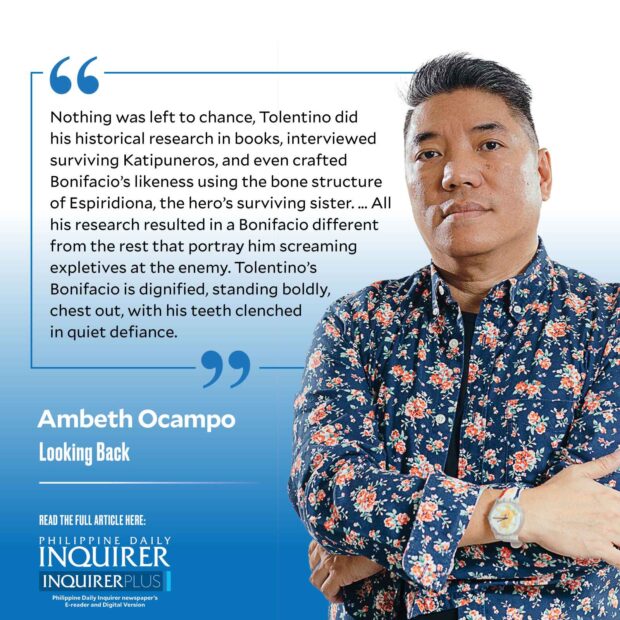Scaling the Monumento

Another item was ticked off my bucket list last week, I climbed the Bonifacio Monument in Caloocan. I have long sought to study the details on each of the 23 bronze figures crafted by Guillermo Tolentino that visually tells the story of the Philippine Revolution, but have only seen them from ground level. I wanted to see the story unfold, eye-level, from the execution of Gomburza in 1872 to Andres Bonifacio’s 1896 Cry of Balintawak (or Pugad Lawin or Pasong Tamo or Bahay Toro or Kangkong or wherever your favored primary source locates it). First time I visited was in 1987, when it was still possible to cross the street into the rotunda where the “Monumento” stands. I visited again on Bonifacio Day 2009 to lay a wreath. It’s a pity that the public cannot visit this declared National Cultural Treasure and Historical Landmark today without assistance of police who will momentarily stop vehicles swirling around the rotunda and get you safely across. Monumento is continuously fed with traffic from the southern ends of: Edsa, Rizal Avenue, MacArthur Highway, and Samson Road.
Studying the monument with binoculars from the Manila Metro Rail Transit System platform or windows of the malls around is one option. Getting a permit to fly a drone round it is also a possibility. Opportunity came when the National Historical Commission of the Philippines (NHCP) was sprucing it up for Bonifacio Day 2023. While the conservation team did not have a hydraulic lift, I was assured that ladders and scaffolding would make it easier than my climb up the Rizal Monument years ago. After being fitted with a hard hat and safety harness, Chad Baula of the NHCP led the way while explaining the process of cleaning the bronze of soot and repairing the finial of the Katipunan standard, broken off by a piece of falling granite from the pylon. When I made it to the base of the monument, a quarter of the way, I looked 45 feet up the pylon, to the tips of the Winged Victory’s delicate toes landing on the point of the obelisk. I started to hyperventilate, and chickened out.
Nevertheless, being on the base of the monument allowed me to examine the first group of figures depicting the three martyr priests: Mariano Gomes and Jacinto Zamora lay dead, the folds of their cassocks, though made of bronze, hung gingerly on the edge of the platform. Central figure was José Burgos seated on the garrote, his face covered, his body tense, and his hands and fingers clutching at life while on the throes of death. It was a terrifying sight.
On the other side of the monument was Tolentino’s Bonifacio. Unlike other depictions, Bonifacio does not wear a camisa de chino. He is garbed in beautifully embroidered barong Tagalog, his pants held firm with drawstrings by the ankles. Bonifacio’s feet are bare and fine, unlike the rough, splayed feet of one of the Katipuneros near him. Bountiful rice stalks, bent and ready for harvest, stand round the hero who carries a bolo in his right hand, a revolver in his left. A holster of tooled leather with the letters “KKK” hangs on his right waist, a wooden scabbard on the left. Nothing was left to chance, Tolentino did his historical research in books, interviewed surviving Katipuneros, and even crafted Bonifacio’s likeness using the bone structure of Espiridiona, the hero’s surviving sister.
As an active member of the Unión Espiritista Cristiana de Filipinas, he interviewed historical figures from beyond the grave. All his research resulted in a Bonifacio different from the rest that portray him screaming expletives at the enemy. Tolentino’s Bonifacio is dignified, standing boldly, chest out, with his teeth clenched in quiet defiance.
From the scaffolding one can clearly make out the artist’s name “G. E. Tolentino” on the left side of the base where Bonifacio stands, on the other side is etched the name of the foundry, “Fonderia M.A.F. Tenca 95 Milano,” where the bronze figures were cast. While the letters M.A.F. stand for “Moderna Fonderia Artistica” established in the 1870s; the letters also signify the surnames of the bronze casters: Menescardi, Austoni, and Figini. The address of the foundry was [Via Carlo] Tenca 95, Milano.
It is said that some of the figures were based on real people: the second wife of Sen. Teófilo Sison, his assistant Anastacio Caedo, and a laborer named Pablo. Caedo, for example, appears as a young Katipunero cradling the corpse of a child. One would think that with the figures made larger than life and seen from the ground, Tolentino would scrimp on detail. Not so, if you look closely at the mother mourning the loss of her child, your sight will go beyond her disheveled hair to her young face where a teardrop rolls down the side of her nose. By the time he was declared National Artist in 1973, Tolentino, like his friend Fernando Amorsolo, was dismissed as old-fashioned and obsolete by modernists. God, they say, is in the details. Much in Tolentino’s “Monumento” lies in wait for rediscovery and appreciation.
—————-
Comments are welcome at aocampo@ateneo.edu




















